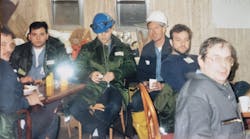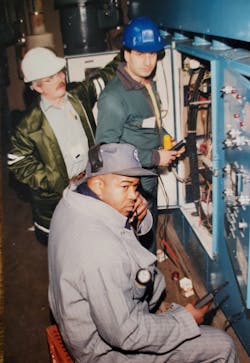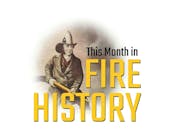Editor's Note: This article orginally ran two years ago on the 30th anniversary of the bombing.
When someone mentions the attack on New York’s World Trade Center (WTC), thoughts immediately turn to Sept. 11, 2001. The 9/11 terrorist attack killed a reported 2,753 people at the site, including 343 members of the FDNY. It was among the most tragic days in American history. It was a day to “Never Forget!”
But, when discussing the attack on the WTC, there is a large group of people who have another date that they will never forget—Feb. 26, 1993. It was on this day that the first attempt to bring down the towers occurred.
Among those who will never forget that day 30 years ago this weekend is a small group of WTC electricians who were working that day. Gregory Rodman and John Daddario were among that group.
Rodman, now the shop steward at Rockefeller Center/NBC remembers it starting out as a typical day.
“I was on the B-4 level, which is four grades below level, with Kevin Flannery and we went back to the workshop because my girlfriend (now wife) Donna had been beeping me,” Rodman recalls.
Daddario, who is now the vice president of operations for a technology service provider, was taking care of business on the B-2 level.
The explosion
A few minutes after noon, a yellow rental van filled with approximately 1,200 pounds of explosives entered the underground parking garage on the B-2 level. The driver parked it against the load-bearing south wall, just 150 feet away from where Daddario was stationed. At 12:17, the bombs detonated setting off a tremendous explosion. Fortunately for Daddario and crew, in those 150 feet were some office spaces, elevator shafts and the 1 WTC perimeter wall, which absorbed most of the blow.
“My first thought was that an electrical substation had exploded,” Daddario recalls. “But a co-worker ran out and reported that the substation, which was on B-1 was still there.”
Rodman’s thoughts also turned to the substation. “Just as we got to the shop, we heard this huge explosion,” he recalls. “Then there was this weird feeling like the floor was going up and the ceiling was coming down. It’s hard to explain, but I remember it like it was yesterday.”
Rodman and Flannery heard calls from some of the mechanical workers who had become trapped on the B-2 level. The pair rushed to help their co-workers. Moments later, Rodman felt someone grab his shoulder from behind. It was a member of the FDNY who told the pair to get out of the building ASAP. Rodman couldn’t believe how fast the FDNY response was and how well trained and professional the members were. “They were there in minutes and took total control of the situation,” he said.
Initial reports indicated an electrical transformer explosion had occurred in the garage beneath the hotel. Firefighters would have to search through the heavy smoke and debris to find the location of the fires and determine what exactly had happened. The only thing for certain was a major explosion had occurred and that a tremendous amount of thick smoke was filling the complex.
First responders discovered that the Port Authority Police Department’s Operations Control Center on level B-1 had been heavily damaged. This was also the fire command station for Buildings 1, 2, 4 and 5. The complex’s standpipe system was damaged, and the fire alarm and public address systems were completely out of service.
As smoke began to fill the workshop, Daddario and crew took to the radios to see if everyone on the team was accounted for and okay. The supervisor ordered them to evacuate the premises. They headed to a nearby stairwell, stopping to help others along the way. The stairs took them to the concourse level just opposite the revolving doors of 1 WTC.
“Upon entering the concourse, I clearly recall looking through the glass revolving door and windows that separated the 1 WTC lobby from the concourse shopping area and seeing nothing but the entire lobby filled with thick smoke, Daddario said.
“Periodically, there were people coming through the doors with FDNY, PAPD, other PANYNJ workers helping get people outside of the complex for medical help.”
Once outside, the electricians were approached by officers from the FDNY.
“There was a decision to try and restore power to the towers to help get people that were stuck in elevators,” Daddario remembers. “In order to do that myself and two of my colleagues walked up to the top of 1 WTC, while three other colleagues walked up the stairs in 2 WTC.
“Being very familiar with the entire complex, we connected with the FDNY and escorted them up the stairs so they could assist office workers who were stuck in the smoke-filled towers. There was a coordinated effort with supervision below to systematically restore power to each tower, which assisted the FDNY with evacuations.”
“There was so much smoke,” Rodman recalls. “Even with my flashlight I could not see a foot in front of me. I don’t know how we made it.” While the electricians made their way up the 110-story buildings, the first responders were faced with a massive search-and-rescue operation.
The rescues
An already intense rescue effort became even more complex a few minutes later. On a ramp leading to the underground garage, Firefighter Kevin Shea of Rescue Company 1 was moving toward the sounds of voices calling for help when a piece of the concrete floor gave way beneath him. Shea plummeted more than 30 feet.
Moments after Shea’s fall, Battalion Chief Richard Rewkowski, who had been supervising several engine companies stretching a line from the hotel to the fire area, heard the mayday on his radio. When they found the hole where Shea had fallen through, Rewkowski said, “It was like looking into the crater of a smoking volcano.”
Eventually, Lt. John Fox was lowered by a life-saving rope into the crater in hopes of finding Shea. After what seemed like a lifetime, the officer radioed back. He found Shea. It appeared as if Shea had several injuries but was in fairly good shape. Other teams of firefighters converged on Shea from different directions. He was treated, placed in a Stokes basket and moved up to street level before being transported to a hospital with a broken kneecap, stress fractures in both feet and a broken nose.
While this was happening, another group of first responders followed the sound of muffled voices to a pile of metal lockers and concrete debris. They dug frantically and uncovered an elevator pit containing 16 trapped workers who had been blown into the shaft by the initial blast. The injured were quickly removed. Several dramatic rescues were made of individuals trapped on isolated sections of concrete hanging above the gigantic crater.
The aftermath
The general evacuation of WTC tenants took more than four hours. Rescuers checked more than 200 elevator cars—freeing trapped people from 45 of them—and searched each floor of the World Trade Center complex, more than 8 million sq. ft. of space.
Rodman, Daddario and crews got power back on that night, but they lost six of eight feeders, so they had no heat. The electricians worked 12-hour shifts around the clock for months restoring the fire alarms and fixing various other issues. Amazingly, they had Cantor Fitzgerald, whose corporate headquarters took up the 101st to 105th floors of the WTC, up and running that Monday, just three days after the bombing. (Cantor Fitzgerald would heartbreaking lose all 658 employees who showed up for work on 9/11.)
The FDNY response turned into the largest movement of apparatus to date in the history of the department. During the initial 24 hours of operations, there were 135 responding FDNY companies with approximately 775 uniformed members on scene. The equivalent of 23 alarms were called.
In all, six civilians were killed and more than 1,000 were injured (mainly smoke related), with more than 450 of those treated at hospitals. More than 100 members of the department were injured while operating with five of those members being admitted to the hospital. Thirty-five police officers and one EMS worker also were reported injured. Ten members of the fire department were awarded medals of valor for operations at the World Trade Center and 25 companies were awarded unit citations for their rescue efforts.
The next day, Rodman and co-workers Mike Catuogno and Fred Guarino were retracing some of their steps and realized how perilously close they came to disaster. The blast had created a five-story, 150-foot-wide crater, filled with 4,000 tons of rubble, in the sub-grade levels of the towers and undermined the floor of an adjoining hotel.
“We had walked right past this giant hole in the floor without being able to see,” Rodman said. ‘I don’t know how we didn’t fall through it.”
Between not falling through that hole and not being in the locker room, which was destroyed by the blast, Rodman feels very fortunate to still be here.
“I’ve heard so many stories of people surviving because they were not where they would usually be…I guess we owe it to fate!”
After 30 years, Daddario says he remembers almost every minute of that horrific day.
“I personally knew four of the six people who lost their lives,” he says. “I’ll never forget them.”
There were many heroes that day. The FDNY responded quickly, efficiently and heroically, performing many rescues and saving many lives. But the Local 3 electricians at the World Trade Center were clearly heroes as well.
On this 30th anniversary, we salute them and we remember six victims who lost their lives that day: John DiGiovanni, Robert Kirkpatrick, Stephen A. Knapp, William Macko, Wilfredo Mercado and Monica Rodriguez Smith, who was pregnant when she was killed. Their names are now forever inscribed in bronze on the 9/11 Memorial.
Watch: Eyewitness News ABC7/NY archival footage from that day
Sources:
WTC: In Their Own Words, Edited by Harvey Eisner
Justice…But Then More Tragedy
According to FBI.gov, an Islamic fundamentalist named Mohammad Salameh had rented the van used in the WTC bombing. One clue led to another, and they soon had in custody three more suspects—Nidal Ayyad, Mahmoud Abouhalima, and Ahmed Ajaj. They also found the apartment where the bomb was built and a storage locker containing dangerous chemicals, including enough cyanide gas to wipe out a town. All four men were tried, convicted, and sentenced to life in prison.
The mastermind of the World Trade Center bombing was Ramzi Yousef, who was captured in Pakistan in February 1995, returned to America, and convicted along with the van driver, Eyad Ismoil.
The FBI would later learn from Yousef that his World Trade Center plot was far more sinister. He wanted the bomb to topple one tower, with the collapsing debris knocking down the second. The attack turned out to be something of a deadly dress rehearsal for 9/11. With the help of Yousef’s uncle Khalid Sheikh Mohammed, al Qaeda would later return to realize Yousef’s nightmarish vision.
Anniversary Services
To mark the 30th anniversary of the WTC bombing, the 9/11 Memorial & Museum is hosting a 30th Anniversary Commemoration on Feb. 26 at noon at the 9/11 Memorial North Pool. A moment of silence will be observed at 12:18 p.m. The ceremony is for victims’ family members, survivors, first responders, and lower Manhattan residents and workers. Community members are also invited to visit the Museum before or after the ceremony. Tickets can be reserved here. If you are unable to attend, the ceremony will be livestreamed at 911memorial.org/watch.
A special public program will be held the following day, Feb. 27, at 6 p.m. in the Museum Auditorium. Marc Smerling, Emmy-winning producer and creator of the new Apple Original podcast, Operation: Tradebom, will host “30 Years Later: The 1993 Bombing and Operation Tradebom”. Smerling will be joined by three individuals featured in the podcast: former FBI Agents John Anticev and Frank Pellegrino, and former NYPD officer Cory Cuneo. Together, in conversation with Museum Director Clifford Chanin, they recount responding to the attack; discuss Tradebom, the FBI’s investigation into the bombing; and reflect on how the first attempt to bring down the Twin Towers changed our world. Register here.
Related Content
Over the years, Firehouse.com has presented some articles looking back at that day and checking in with survivors years later.
‘First’ WTC Mourners Mark 10 Years
1993 Victims Reliving Own WTC Anguish
Victims Mark 25 Years Since World Trade Center Bombing







